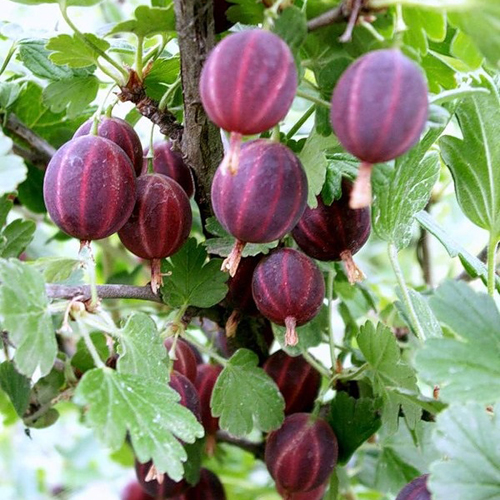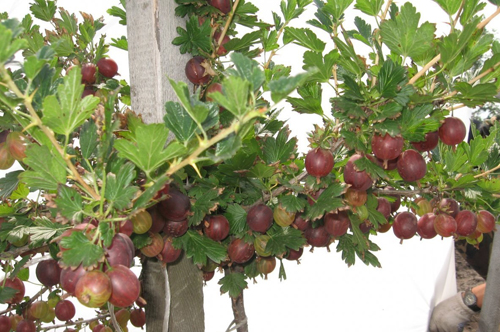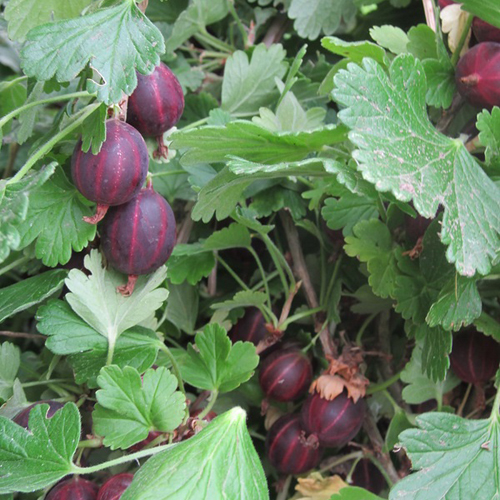Gooseberry variety Consul (Senator)
Gooseberry is a valuable crop, especially beneficial for children and the elderly. But here's the problem - the bush is very thorny, and harvesting is not so easy. That is why many gardeners refuse to plant this crop on their site. But you should not deprive yourself of the joy of eating your favorite berry, because gooseberry varieties with a limited number of thorns or absolutely devoid of them have already existed for a long time. Consul is considered the most successful among the studless types. Its author V.S. Ilyin got a novelty by crossing the Chelyabinsk Green and African varieties. The applicant FGBNU "Ural Federal Agrarian Research Center of the Ural Branch of the Russian Academy of Sciences" registered a new species in 1988. The gooseberry was introduced to the State Register of Breeding Achievements of the Russian Federation in 1995 under the name Senator. Regions of admission - Volgo-Vyatka, Ural, West Siberian, Far East.

Description
The described variety has good vigor and forms a dense, relatively sprawling bush. Height is about 1.8 meters, the diameter of the crown of an adult plant can reach 2 meters. The upright or slightly curved shoots of the Consul are not too thick, without pubescence, with a green bark, sometimes a brownish-pink tint can appear in their lower part. Two-year-old shoots acquire a brownish bark. Slightly thorny shoots, the upper part of the shoot, its base and replacement shoots without thorns. The available thorns are weak, solitary, perpendicular to the shoot or slightly downward. Gooseberry leaves are of normal size, not too dense, green. The surface of the leaf is wrinkled, weakly or moderately shiny. The Consula's leaf plate is straight, concave or convex. The base of the leaf is straight or rounded, with a shallow and wide notch. The shape is five-bladed, with deep cutouts. The central lobe is larger than the lateral ones, has additional projections, the edges are directed at a slight angle to the central vein and are slightly bent. The lateral lobes are widely spaced, the angle between the median veins of the lateral lobes is sharp. The denticles are irregular, most often short, obtuse. The basal lobes are poorly developed. The petiole is thin and long, covered with light pubescence, light green in color, attached to the shoot at an angle of 30 °. The petiole trace is wedge-shaped. The buds of the variety are oval, small, solitary, grow, deviating from the shoot. Gooseberry flowers are brightly colored, small in size, collected in one-flowered or two-, sometimes three-flowered inflorescences. Sepals are narrow, not too long, not closed, curved. Pedicels are not pubescent, green, thin and long.

Consul berries are round, medium to large in size - the minimum weight is 2.6 grams, the maximum is 6.3 grams. The State Register indicates an average weight of 3.3 grams. The calyx is closed, medium in size. The peduncle is green, long, thin. The skin is thin. The color of the fruits is red or dark red, at the stage of consumer ripeness it becomes dark burgundy, almost black. The pulp is tender, fragrant, contains a small amount of seeds, almost transparent, marmalade type, melts in the mouth. The taste is sweet and sour, dessert, the average tasting score is quite high, even by the strictest standards - 4.7 points. Ripe gooseberry tastes like well-ripened grapes and delicious kiwi. 100 grams of raw material contains sugars - 6.7%, titrated acids - 3.0 - 3.1%, vitamin C - 25.7 mg.
Variety characteristics
- The consul ripens in medium terms, the crop can be harvested in mid-July. The duration of the fruiting period is about 40 days;
- Senator blooms in the third decade of May - early June;
- fruiting grows gradually. In the first 2 - 3 years, the harvest is small - about 3 kg from one bush. But then this figure doubles and even more - up to 7 kg per plant. The State Register gives the following indicators - the average yield for 1992-1994 was 41.0 c / ha.According to VNIISPK, the minimum yield is 10 t / ha, the maximum is 20 t / ha, from one bush - from 3 to 6 kg;
- given the regions of admission, we can safely talk about the excellent frost resistance of the variety. Without any special damage, the Consula bush is able to withstand frosts at -30 ° C. Even if freezing occurs, the plant has a high regenerative capacity. Flowers show high resistance to spring frost even in cool regions;

- due to its high plasticity, gooseberries adapt perfectly to hot weather, respectively, can tolerate dry periods, which are increasingly occurring even in the Far East;
- the variety is self-fertile, which is a huge plus. This feature will allow 44.7% of the total crop to be set even without cross-pollination. But, of course, the right pollinators will greatly improve the quality of the fruit and increase the yield;
- the immunity is excellent, the variety is especially valued for its high resistance to the most insidious disease of the culture - powdery mildew. There is an average resistance to septoria and sawfly. But in especially unfavorable years, the plant can suffer from rust or anthracnose;
- the transportable ability of the Consul fruit is not very high - a thin skin will not help the berries to maintain their presentation. In the refrigerator, the harvest of this variety can be stored for about a week. Freezing will help to increase the shelf life;
- the way of eating fruits is universal. It is best to eat ripe berries fresh, so the body will receive the maximum amount of vitamins and minerals. But in winter, you can pamper yourself with jam, because there are not very many seeds in the pulp of the Senator and nothing will interfere with enjoying a tasty and healthy product. In addition, you can make marmalade, jam, baking stuffing from gooseberries.
Planting and leaving
The timing of planting seedlings is chosen based on the climatic features of the region. In the south, the best time is autumn. In cooler temperatures, it is best to start planting in the spring, but you need to be in time before budding begins. If the seedling has a closed root system, then it can be planted even during the summer. Choose a place that is as illuminated as possible, although the variety can tolerate light partial shade. But in the dense shade, the Consul's harvest will ripen much later, the berries will be small, and the taste will be dominated by sourness.
Of the soils, preference should be given to loam or sandy loam, characterized by good moisture and air permeability. Another important condition is the nutritional value of the soil, therefore, on poor soils, nutrients should be added to the planting pit. Caring for gooseberries is not special. Agricultural technology includes weeding and loosening the near-trunk circle after moistening. Watering is moderate, but in a hot period, the frequency of humidification should be increased. Top dressing is required - nitrogen-containing fertilizers are preferred in spring, phosphorus-potassium fertilizers during the formation of the ovary. Do not forget about pruning and preventive treatments for diseases and pests.
Consul is a reliable variety that, due to its good winter hardiness and plasticity, can be grown in regions with difficult weather conditions. Good yield, high taste, and most importantly, the absence of thorns make the Senator very attractive for planting in the garden. The plant is excellent not only for group plantings, but also for single plantings, due to its high self-fertility. There were no obvious disadvantages in the cultivation of this gooseberry. Although sometimes there are reviews of small and sour berries.








